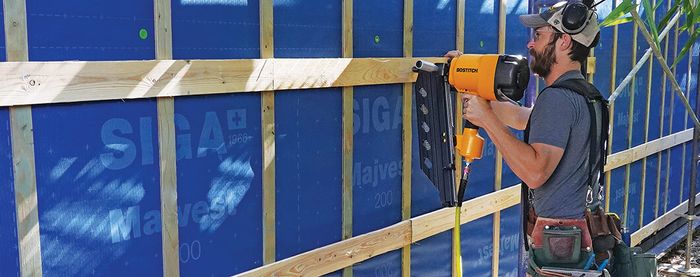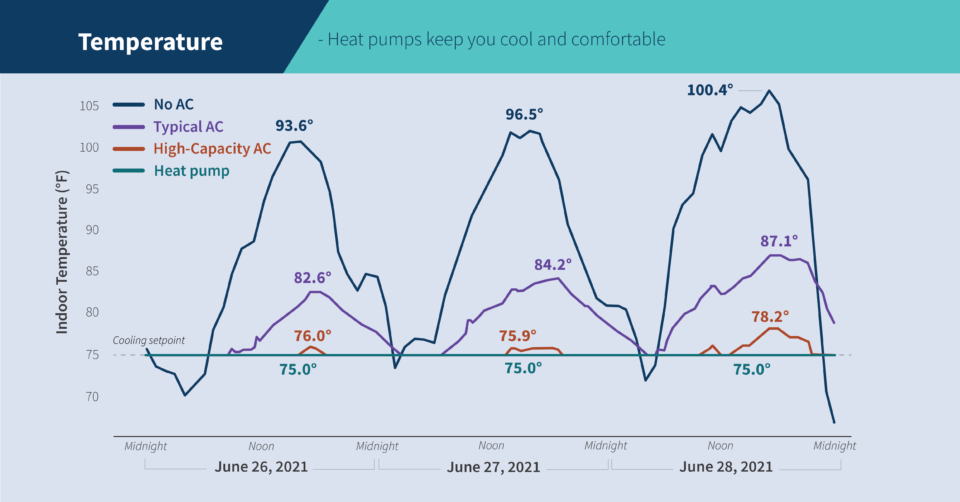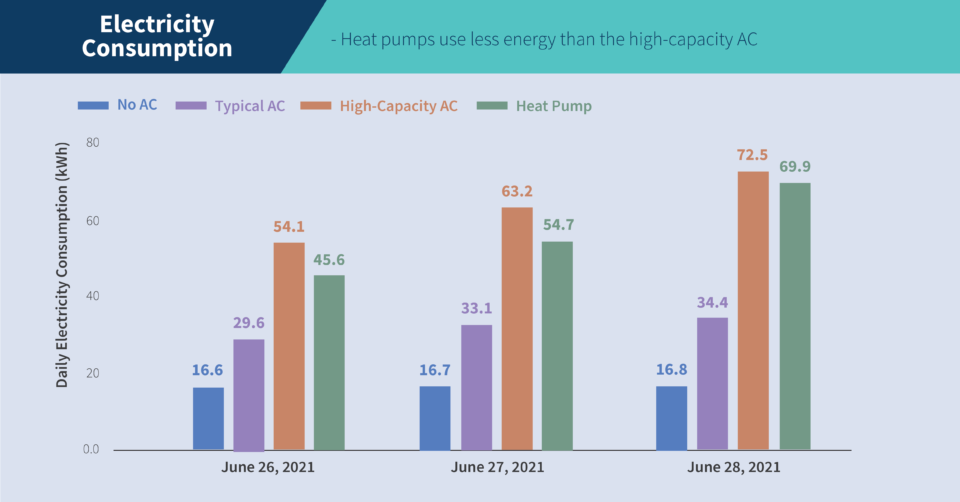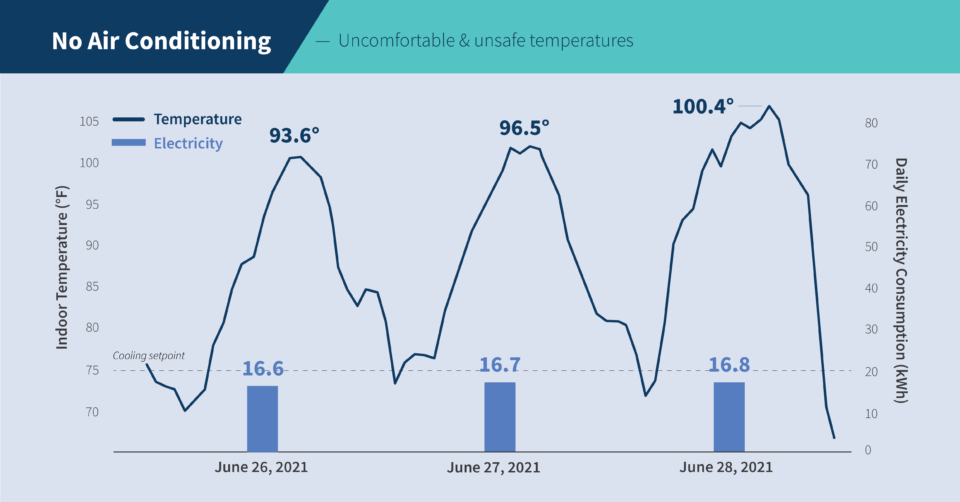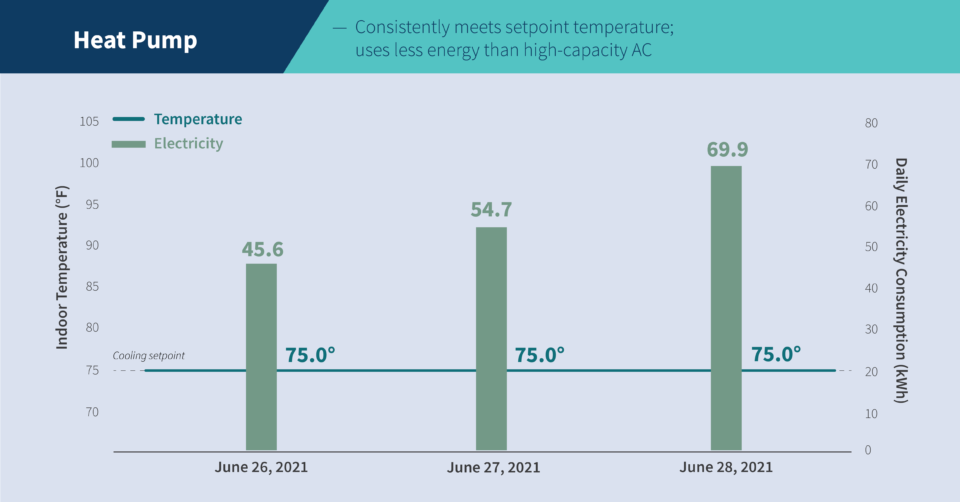Why Heat Pumps Are the Answer to Heat Waves
In this modeling, a heat pump is more economical and more effective than an AC unit.
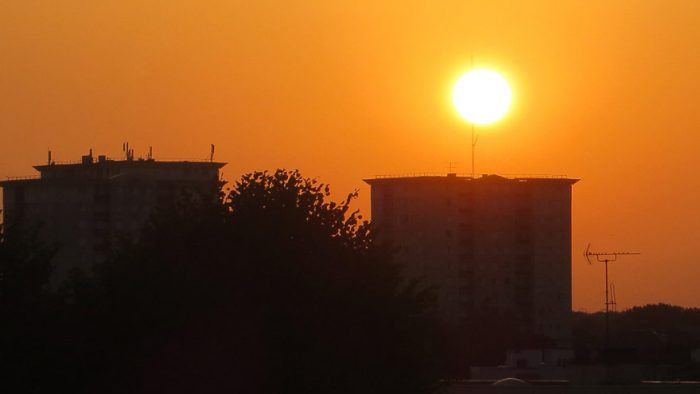
By Lacey Tan
As a record-breaking heat wave scorched the Pacific Northwest in the summer of 2021, killing hundreds of people in the United States and Canada, many residents realized the predictably mild summers they knew no longer exist. Scientists are clear that climate change will make these extreme heat events more common in the coming years, prompting people in historically mild-temperature areas like Seattle, Portland, and Northern California to add air conditioning (AC) to their homes.
In Seattle, where 46% of single-family homes do not have air conditioning, temperatures reached a scorching 108°F on June 28, creating hazardous conditions inside homes. So how do we keep people safe and comfortable during dangerous heat waves and manage the increasing need for air conditioning in a climate-friendly and equitable way? Heat pumps are an attractive solution for both policymakers and residents alike, as they can keep a home cool and comfortable in an efficient manner in the summer while also heating the home without fossil fuels in the winter.
RMI modeled the performance of several cooling options for a Seattle home during the three-day heat wave in June 2021: an air-source heat pump (hereafter heat pump), a typical AC unit, and a higher capacity AC unit. We found that the heat pump was not only capable of maintaining a comfortable and safe indoor air temperature during extreme heat, but it also costs $228 less per year to operate than a dual fuel cooling and heating system (AC unit + gas furnace). In addition, CO2 emissions are reduced by around 25% for the entire home when it operates with the heat pump compared to the high-capacity AC and furnace.
Heat pumps keep you cool and comfortable
Our results clearly show the heat pump is superior at maintaining a comfortable and consistent indoor air temperature and consumes less electricity than the high-capacity 4-ton AC unit. We first looked at a small 2-ton AC unit—typical for the historically mild Seattle climate—but it failed to maintain a safe indoor environment (cooling setpoint of 75°F) during the extreme heat event. This implies that a high-capacity AC unit is needed to meet the predefined setpoint temperature.
But even while this high-capacity AC unit generates a more pleasant indoor air temperature compared to the typical AC unit, it still struggles to meet the setpoint temperature on the hottest day (i.e., June 28), as shown in the temperature figure below. This is in contrast to the heat pump, which was able to maintain a safe temperature even in extreme heat. The high-capacity AC unit also consumes more electricity than the heat pump, adding additional strain to the grid.
Scenarios and additional findings
Using the National Renewable Energy Laboratory’s BEopt tool, we modeled the following scenarios using a typical existing single-family home in Seattle with no air conditioning, a standard gas furnace and a relatively efficient envelope characteristics as the baseline. The home’s building characteristics are based on the Pacific Northwest National Laboratory’s prototype model and the Residential Energy Consumption Survey 2015 data. This physics-based building energy model uses actual meteorological year weather data from the June 2021 heat wave. Our objective was to see which system could meet a setpoint temperature of 75°F and examine the impacts on the home’s utility bills.
Scenarios:
- No AC: We used a home with a gas furnace with a 78 percent annual fuel utilization efficiency for heating and no AC. We explored the indoor air temperature increase relative to the outdoor air temperature. In this scenario the indoor air temperature has a lag compared to the outdoor air temperature but follows a similar curve and is highly uncomfortable and unsafe for occupants. Indoor air temperature reached a peak 100.4°F on June 28.
- Typical AC: This scenario represents a typical capacity AC unit that we would expect for a Seattle home with the characteristics laid out earlier. Historically, AC was not a necessity in Seattle’s climate; however, it is now a necessity to cope with recent heat waves and rising temperatures. We added a typical 2-ton AC unit with a 2-stage compressor and a seasonal energy efficiency ratio (SEER) of 18, keeping all other assumptions the same in the model. The typical AC unit reduces the indoor air temperature to levels that are closer to the 75°F cooling set point temperature; however, it is not capable of meeting the setpoint temperature. Thus, this scenario is only marginally safe and uncomfortable for occupants.
- High-capacity AC: We replaced the typical AC unit with a high capacity 4-ton SEER 18 AC unit with a 2-stage compressor, keeping all other assumptions the same. This scenario generates a more pleasant indoor air temperature compared to the typical AC unit, but it still struggles to meet the setpoint temperature on the hottest day (June 28), and it consumes a large amount of electricity compared to the typical AC unit.
- Heat pump: In this scenario, we analyzed a variable speed SEER 22 heat pump without the gas furnace. The heat pump generated the most pleasant indoor air temperature and was able to consistently meet the setpoint temperature and uses 18.6% 15.5%, and 3.7% less energy than the high-capacity AC unit for June 26-28, respectively. It also performed better compared to the high-capacity AC unit and furnace in terms of energy consumption, carbon emissions, and operating costs when used for both heating and cooling.
Additional findings:
- A heat pump provides both cooling and heating, so we explored its ability to heat the home during the winter months and compared it to a standard gas furnace. The heat pump was more efficient in terms of energy consumption, carbon emissions, and operating costs at heating the home compared to the gas furnace. By removing the furnace and installing a heat pump, the carbon emissions for the whole house are reduced by over 10,000 lbs of CO2.
- Heat pumps are an effective and climate-friendly solution for addressing increasing cooling needs in regions like the Pacific Northwest. Installing a heat pump that uses less energy for both heating and cooling than high-capacity AC unit is a long-term investment that can reduce utility bills but has a higher upfront cost that can be a barrier to market adoption.
- The AC needs to be oversized to provide acceptable indoor air temperatures in case of extreme heat waves. However, in temperate climates with a high heating need compared to cooling, a heat pump is appropriately sized to handle the heat wave conditions.
- Although not analyzed in this blog, studies have shown weatherization services provide improvements that lower energy consumption and increase overall energy efficiency and are a good starting point for poor housing conditions. Combining weatherization due to efficiency gains could lead to downsizing equipment, resulting in greater savings. They also provide non-energy benefits like health and safety, which are greatly needed for low- and middle-income households.
A key inflection point
While more and more people in the United States and around the world look to add cooling to their homes, it’s important to ensure that cooling equipment has minimal climate impact. In hot regions with growing access to AC, (e.g., India), advanced technologies like those demonstrated through the Global Cooling Prize will be critical. In historically mild regions grappling with new heat waves, like the Pacific Northwest, there is an urgent opportunity to provide clean heating simultaneously with efficient cooling.
This summer’s extreme heat events present a clear opportunity and an intervention point for policy makers to support the deployment of heat pumps today, especially in more temperate to cold climates. The economics and energy use between the two systems make the case for incentivizing heat pumps to not only meet the increased demand for AC, but as a strategy for reducing carbon emissions and meeting climate action goals. Once a homeowner installs their first central AC unit, it’s a missed opportunity to get polluting fossil fuel or inefficient electric resistance heating out of the home for at least 15 years.
To make this transition easier for households, lawmakers and utilities can drive adoption of modern heat pumps with new programs and incentives that make them affordable for more homes and reduce the upfront cost barrier. A recent piece of federal legislation introduced by Sen. Martin Heinrich (D-N.M.) would help consumers transition to all-electric homes by providing up to $10,000 in rebates, or $14,000 in the case of low-and-moderate income households. This bill has a particular focus on the space heater, water heater, and electric system.
Efficiency measures are a key counterpart to electrification and should also be prioritized, along with carveouts to ensure low and middle-income households can be early adopters of clean and efficient technologies.
Meeting our essential climate targets requires eliminating emissions from every sector, including buildings. That means policymakers across the country need to be prioritizing the transition to efficient, modern, electric appliances like heat pumps. As climate change drives increasingly extreme and dangerous weather conditions, these devices can also play another essential role: keeping people comfortable and safe in their homes, even under the worst conditions.
Addendum
The equipment chosen for this analysis represents typical scenarios in Seattle: a home without AC and a home with a modest 2-ton AC. The high-capacity 4-ton SEER 18 AC represents what a customer might buy if they were frustrated by high indoor air temperatures and wanted to stay cool during the heat wave. The rationale behind a customer choosing a 4-ton SEER 22 variable speed heat pump is the added benefit of improved cold weather performance if used as the primary heating source. This heat pump would be used more often than a standalone AC, resulting in a shorter payback period. We chose not to analyze a high-capacity SEER 22 variable speed air conditioner in our original analysis, as we do not expect it represents a common consumer choice in this context, given the increased expense and low utilization of its large cooling capacity, and given that it lacks the heating and emissions benefits of a heat pump.
The heat pump, as defined in the blog, has a variable speed compressor. We expect that a SEER 22 AC with a variable speed compressor would provide similar comfort and energy performance for cooling. However, a heat pump not only provides cooling, but heating as well. Considering that most residential units in the Seattle region do not have an AC, this could be an opportunity to efficiently address both heating and cooling, as heating provided through the heat pump is around three times more efficient than heating provided through a furnace.
Previously published on GreenBuildingAdvisor.com. Lacey Tan is manager of Carbon-Free Buildings at the Rocky Mountain Institute. Mohammad Hassan Fathollahzadeh is an associate in the same program. This post was originally posted at the RMI Outlet and is republished here with permission. ©2021 Rocky Mountain Institute.
